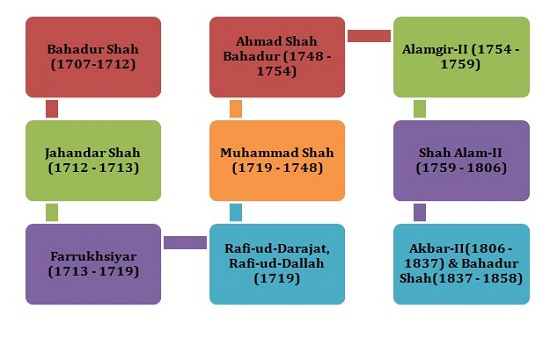

The Mughal ruling period plays a significant role in shaping the future of India. They also had some notable works, which made them impactful rulers who ruled the country through seven generations. The first ruler Babur, who was the Chagatai Turkic prince, established the empire. It finally ended with Akbar-II and Bahadur Shah-II.
The Mughal Empire is also known as the “period of great Mughals”. It started with Babur in the year of 1526 A.D. and started falling in 1707 A.D with the death of the last powerful emperor Aurangzeb
The clashes that started in the era of Aurangzeb became major after his death because of the availability of strong successors. At the time of his death, the empire was the largest in India, however, with his death, the whole scenario changed. After his death, his three sons “Muazzam, Muhammad Azam and Muhammad Kam Bhaksh” started fighting with each other for the throne.

Muazzam − He was one of the sons of Aurangzeb and after killing his brothers in the battle, he captured the throne, and he was known as Bahadur Shah. He ruled from 1707 to 1712, it ended with his sudden death.
Jahandar Shah − The death of Muazzam started a battle between his four sons to decide the next ruler. Among them, three were killed and Jahandar Shah ascends the throne. However, in a year, the son of his brother, Farrukhsiyar took control over the throne.
Farrukhsiyar − He was a cowardly ruler and the real power of the states was in the hands of the Sayyid brothers. In 1719, he was ruled over and was executed by his ministers, the Sayyid brothers.
Rafi-ud-Darajat, Rafi-ud-Dallah − Sayyid brothers made two kings who were capable to rule the throne, Rafi-ud-Darajat, and Rafi-ud-Dallah and they were the sons of Rafi-us-Shan. After a few months, Roshan Akhtar, a young ruler, replaced them.
Muhammad Shah − In 1719, Roshan Akhtar ascended to the throne and named Muhammad Shah. However, being a comparatively powerful ruler he did not allow the Sayyid brothers as agents. Because of his inactive life soon, the empire started slipping out and Marathas took back their power. The rise of Nadir Shah hit the total empire and in 1748, he was ruled out.
Ahmad Shah Bahadur − After Muhammad Shah, his son took the throne but was unable to hold the empire because of the lack of capability of ruling and it ended in 1754.
Alamgir-II − Jahandar Shah’s son Alamgir-II who took the title of Aurangzeb started ruling and he wanted to make himself free from the control of the kingmakers which results in his death .
Shah Alam-II − Alamgir-II’s son was the next ruler, known as Shah Alam-II. Gulam Qadir, the Afgan chief, blinded him. In 1803 when the British took control, he became prisoner and he was there till his death.
Akbar-II and Bahadur Shah-II − Akbar-II and Bahadur Shah-II were just allotted a home and the British used them as puppets. However, in 1858 the glorious Mughal Empire finally falls apart.
Behind the fall of the Mughals, there are many causes however; the most important one is the lack of control over the empire, the rise of regional forces and the lack of initiative toward the modern kind of weapons. Most importantly, the land relation’s deterioration is the other cause
The most causes of the decline of the Mughal Empire were
Lack of capable rulers and somehow major Mughals after Aurangzeb’s death were weak successors.
One of the major characteristics of the Mughal Empire was the nobility. The clashes and the fights for power made the strongest empire weaker in less than 50 years.
There was no strong financial support and the chances of foreign invasions were less. Even the revenues git depleted because of the emergence of many states.
The rise of British rule played a major role in the falling of Mughal rules.
The falling of the largest ruling of India increased the chances of the rose of many regional forces and powers. The lack of capable rulers among Mughals and the strong army, pave the way for those states. However, those regional states that emerged after the Mughals can be divided into three major types
Those states that were formed by the nobles, who were associated with the Mughals
In the 18th century the rise of the Watan Jagris, they also once served under the Mughals
Those states that raised as rebels and emerged against the Mughals
The Mughals had a great impact on the making of the history of India. Mughals were actually of Turkic-Mongol origin and they ruled most of India for a long period. After the 18th century, they continued ruling till the 19th century but mostly as a powerless entity.
Q. Why did the Mughal Empire start falling after Aurangzeb?
Aurangzeb was considered the last most powerful and impactful Mughal successor. After him others were weak and as a result of it, they became victims of many conspiracies. The lack of a capable ruler and a strong army base made the whole empire weaker and as a result, it fall apart
Q. What did happen after the death of Aurangzeb?
Aurangzeb died without declaring the name of any prince who will rule after him. Because of that, the throne was left off guard and his three sons started fighting for it. Azam Shah first captured the throne and declared himself as the successor, however later he was defeated by his brother Bahadur Shah.